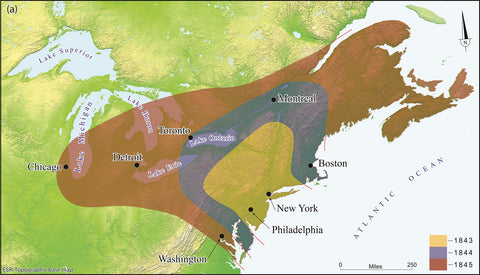
Incredibly, actual leaves from diseased potato crops that devastated Ireland during the Great Famine still exist.
These leaves were originally taken from diseased potato plants at the Botanic Gardens in Glasnevin Dublin in 1846 and 1847. Today they are stored securely in The Herbarium at the Royal Botanic Gardens Kew, London.
177 years ago, the sight of these leaves and the smell of rotting potato plants struck fear into the heart of Irish farmers and labourers across Ireland.
The pathogen that caused the blight was Phytophthora infestans, a fungus-like microorganism that infects potato plants through their leaves, but the full story had always been a mystery.

In 2013, using DNA from these leaves, Researchers identified the specific pathogen responsible for the blight behind the Irish Potato Famine by sequencing its genome.
Phytophthora infestans originated in the Toluca Valley in Mexico, sometime after Europeans began colonising the Americas.
It turned out, contrary to expectations, that the strain that caused the Irish Potato Famine isn't US-1, which still causes blights today around the world -- it's an entirely new strain called HERB-1.
Looking through the genomes they recovered, the researchers found clear evidence that Phytophthora infestans had undergone rapid diversification shortly after the arrival of Spanish invaders in the 1500s. It spread rapidly beyond the Toluca Valley to the rest of the Americas, and to Europe.
HERB-1 appears in the early 1800s, spreading to Europe in 1845 to infect the potato crops. It only died out in the early 1900s, to be replaced by the US-1 strain that continues to destroy crops around the world to this day.

The potato blight that affected America in the 1840s was caused by the same organism, Phytophthora infestans, that devastated potato crops in Ireland during the same period. This blight had significant consequences for American agriculture and society, particularly in regions where potatoes were a staple food.
In the United States, the potato blight first appeared in the northeastern states in the late 1840s, spreading rapidly across the country in subsequent years. Like in Ireland, the blight led to widespread crop failures, resulting in food shortages, economic hardship, and social upheaval, especially among immigrant communities who relied heavily on potatoes as a dietary staple.
The impact of the potato blight in America varied regionally, with some areas experiencing more severe consequences than others. For example, regions with large Irish immigrant populations, such as New York and New England, were particularly hard hit.
The potato blight in America contributed to increased awareness of agricultural pests and diseases, leading to efforts to develop more resilient crop varieties and improved farming practices. It also underscored the vulnerability of monoculture farming systems and the importance of crop diversity in mitigating the risks of disease outbreaks.
Overall, the potato blight in America during the 1840s had significant social, economic, and agricultural impacts, similar to its effects in Ireland and other parts of Europe.